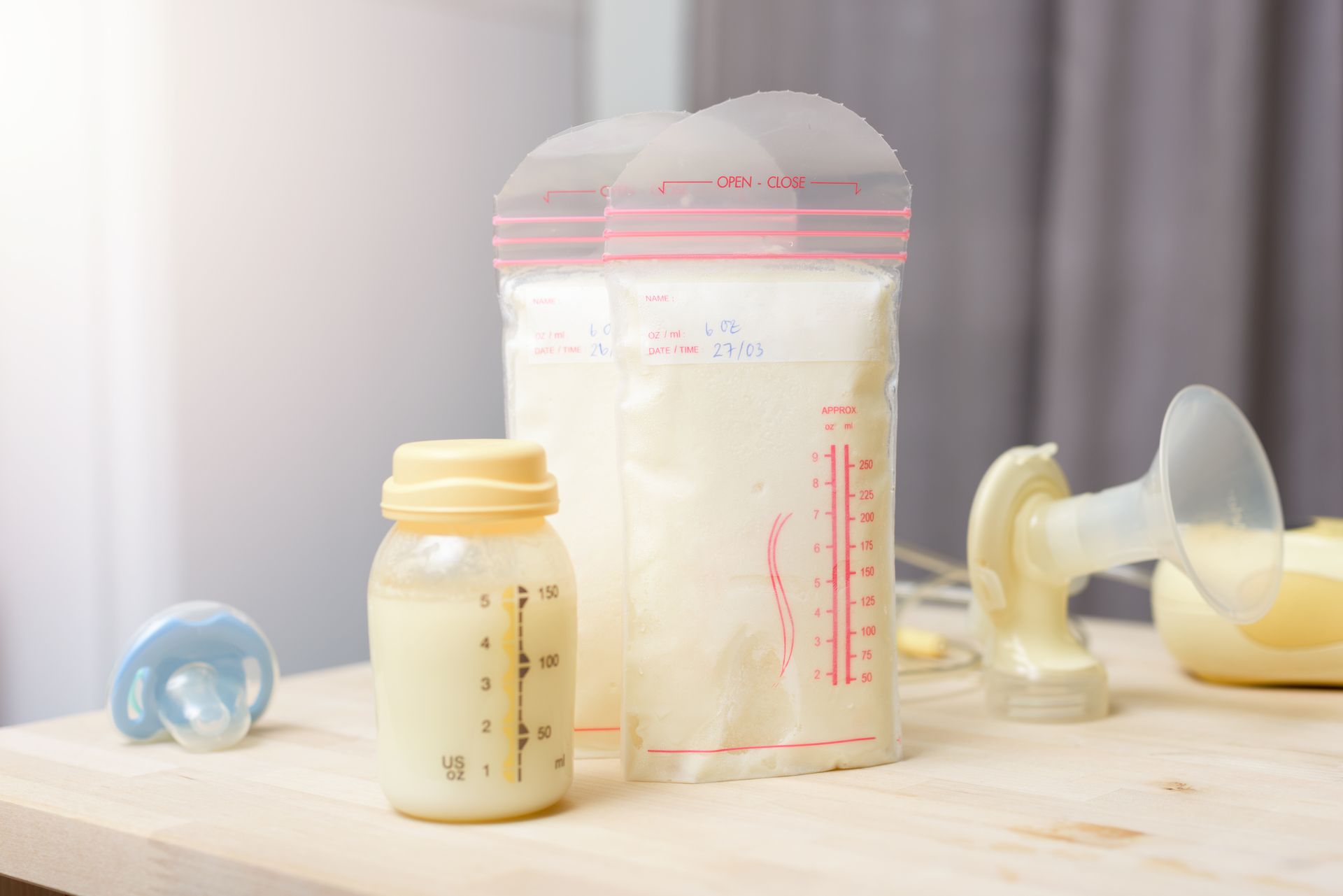Breast milk is considered the best source of nutrition for most babies. It's more than just food; it's a complex blend of nutrients, antibodies, and enzymes that adapt to your baby's changing needs. A crucial aspect of infant care is ensuring breast milk's correct storage and preparation. Following the proper guidelines protects the health and well-being of your cherished little one.
Breast Milk Storage Guidelines
First and foremost, it's crucial to maintain cleanliness when storing breast milk. Thoroughly wash your hands before expressing or handling breast milk. To avoid contamination, make sure to sanitize and sterilize breastfeeding items, like pumping equipment, storage containers, and even prep surfaces. This step is essential for protecting your baby's health.
How to Store Breast Milk
Proper breastmilk storage begins with the right containers. These containers should be made from food-safe materials and equipped with secure closures to prevent leaks and contamination. Here's a closer look at your options:
- Hard Plastic Bottles: These bottles are popular for their reusability and durability. However, avoid bottles with the recycling label “7” as they may contain Bisphenol A (BPA). Choose BPA-free materials to prevent chemical leaching.
- Glass Containers: Glass is an excellent choice for those concerned about plastic. You can sterilize the bottles at high temperatures, and it doesn't absorb smells or flavors. However, glass is heavier and more fragile.
- Breast Milk Bags: The slim design of these specially-designed plastic bags is convenient for freezing, which saves space and allows for quicker thawing. Buy sturdy, leak-proof, food-grade, and BPA-free breast milk bags.
How Long Is Breast Milk Good For?
Knowing how long breast milk lasts in various temperatures is crucial for keeping it safe and getting its full benefits.
- Room Temperature (up to 25°C or 77°F): You can safely leave out breast milk at room temperature for up to 4 hours.
- Refrigerator (at or below 4°C or 40°F): You can chill breast milk in the fridge for up to 4 days. Store it in the back, where the temperature is most consistent, away from the door.
- Freezer (-18°C or 0°F or colder): You can freeze breast milk for 6 months without significant nutrient loss, though it's best to use it within 3 months. Deep freezers, which maintain colder temperatures, can extend this shelf life to 12 months. Leave at least an inch of space at the top of the bag when freezing milk because it expands and could burst.
When storing breast milk, aim to keep amounts of 2 to 4 ounces, or the typical amount offered at a single feeding. Label each container with the date when you express the milk. Organize the containers in your fridge or freezer so that the oldest milk is easily accessible. This "first-in, first-out" method helps you use the oldest milk first, so no milk goes to waste.
Tips for Thawing and Warming Breast Milk
Thawing and warming breast milk correctly is crucial for preserving its nutritional content and ensuring it's safe for your baby to consume. Incorrect methods can lead to the following:
- Nutrient loss
- Bacterial growth
- Hot spots that could burn your baby's mouth
How Do I Thaw Breast Milk from Freezer Storage?
Proper thawing ensures breast milk retains its beneficial properties while preventing bacterial growth.
- Thawing in the Refrigerator: The safest method to thaw breast milk is in the refrigerator, usually taking about 12 hours. Plan ahead by moving the milk from the freezer to the fridge the night before you need it. This slow thawing process helps preserve the milk's nutritional quality.
- Thawing in a Container of Warm Water: Place the bottle or sealed bag in a bowl of warm or lukewarm water. Change the water every few minutes to gradually warm the milk until it's thawed.
- Thawing Under Running Warm Water: Place the sealed bag or bottle under warm or lukewarm running water. Avoid using hot water directly, as it can unevenly heat the milk and potentially damage its nutrients.
How to Properly Warm Breast Milk
If you're using thawed or chilled milk, you may want to warm it before feeding it to your baby. Some infants are happy to drink cold milk, but others prefer it warm. Below are two ways to safely heat breast milk:
- Warm Water Bath: Place the bottle or bag of milk in a bowl of warm water for a few minutes until the milk reaches body temperature.
- Bottle Warmer: Follow the manufacturer's instructions for your specific model to ensure even warming.
Preparing Breast Milk for Feeding
When it's time to feed your baby, always ensure cleanliness first. Thoroughly wash, sanitize, and dry all feeding equipment, including bottles, nipples, and breast pump parts, between uses. This step prevents harmful bacteria from growing.
When using stored milk, always inspect it before feeding. Look for any changes in color or smell. Breast milk that has gone bad will usually smell sour or rancid. If you're unsure, it's safer to discard it. After thawing or warming, gently swirl the bottle or bag to mix the separated fat layer.
Always test the milk's temperature before feeding it to your baby. It should be at body temperature or slightly warmer. The best way to test is by sprinkling a few drops on the inside of your wrist; it should feel comfortable, not hot.
Read:
Breastfeeding While Sick: Is It Safe for My Baby?
FAQs
1. Is it safe to refreeze thawed breast milk?
Once thawed, do not refreeze breast milk. Freezing, thawing, and refreezing increase the risk of bacterial growth and degrade the milk's nutritional and immunological quality.
2. Can I use the microwave to heat breast milk?
Never use a
microwave to thaw or warm breast milk. It is common for microwaves to heat unevenly, causing hot spots that can burn your baby's mouth and throat. Microwaving also destroys some of the beneficial components of breast milk.
3. What should I do if my baby doesn’t finish a bottle of breast milk?
If your baby doesn't finish their breast milk bottle, use the leftover milk within 2 hours or throw it away. After the baby drinks from the bottle, don't reuse the leftover milk because bacteria from their mouth can make it unsafe.
4. How long does breast milk last in the fridge?
Following the proper guidelines, you can store breast milk at the back of the chiller, where it's coldest, for up to 4 days. You can also freeze it for 6–12 months. Once thawed in the refrigerator, use it within 24 hours, starting from when it's fully thawed, not when you first take it out of the freezer.
5. How long is breast milk good for at room temperature?
Freshly expressed breast milk lasts up to 4 hours at room temperature. However, it's best to use or properly store the milk as soon as possible after expression. Your baby must consume breast milk that is warmed or brought to room temperature within 2 hours.
6. Can I mix freshly expressed breast milk with cooled or frozen milk?
Generally, mixing fresh breast milk with milk that's already cold or frozen is not advisable. Doing so can warm up the milk and make room for bacterial growth. But if you want to mix both mixtures, you should first cool freshly expressed breast milk in the refrigerator before adding it to the already cooled or frozen ones. Ensure the volume of newly expressed milk is less than or equal to that of the stored milk to prevent thawing.
Find Support Through Your Motherhood Journey
Every drop of breast milk benefits your little one, so handling it with care is crucial to your baby’s health and development. By following the guidelines in this blog, you can ensure the milk stays safe and retains its valuable nutrients and antibodies.
If you're looking for support or have any questions regarding pregnancy or motherhood, our
certified nurse-midwives (CNMs) are eager to address any of your concerns. For midwifery services in Corona, California, call 951-547-4208 or
complete our contact form to get started.














